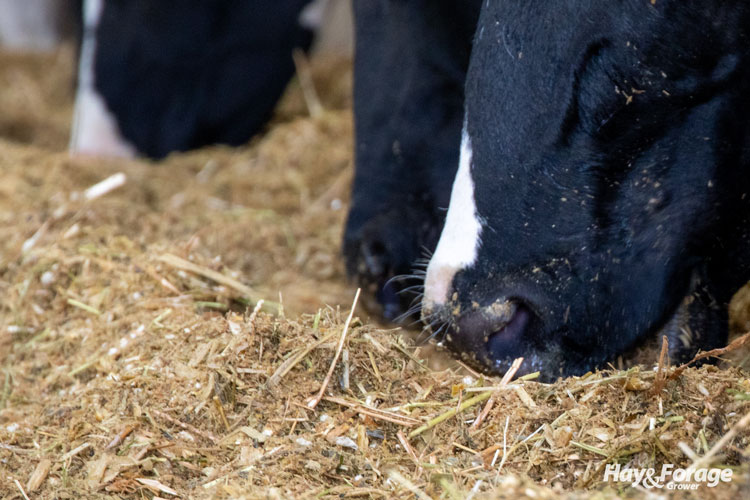
The objectives of feeding cows are to provide a nutritionally balanced and relatively homogeneous ration fed in a way that suppresses selection by cows, has roughly 2% residual in the feedbunk at the end of the day, and results in uneaten residue that is spread out along the bunk. To achieve these outcomes, there are several steps that need to be taken.
Ration formulation: The health of dairy cows depends on a fully functioning rumen. Thus, the ration should provide adequate fiber, energy, and protein to feed the rumen microorganisms. Fortunately, the multiplicity of ingredients, including by-products, available to most U.S. dairy farms provides the opportunity to meet these nutrient requirements within economical dairy rations.
This task is generally the responsibility of the nutrition consultant. It is accomplished using least cost ration formulation computer programs, such as Cornell Net Carbohydrate and Protein System (CNCPS). This “paper ration” is what should be fed to the cows to meet their nutrient needs and maximize milk production, but it is only as good as the skill and experience of the nutritional consultant. So, choose wisely.
Ration preparation: Creating the ration fed to the cows is the responsibility of a feed mixer operator using those paper rations. It is usually facilitated by sophisticated high-capacity loaders and mixing wagons with scales powered by a computer program such as Feed Watch.
This “mixed ration” is the ration that is created by the mixing process, and its similarity to the paper ration depends on correctly defined ingredients, accurate delivery of these ingredients to a fully functioning mixer wagon, sufficient mixing time to form a homogeneous load, and the skill and dedication of a fully trained mixer operator. Thus, the mixed ration is only as good as the accuracy of all the steps in its creation.
Ration delivery: Delivering the mixed ration to the bunk is generally the responsibility of a feeder operator. This “fed ration” should be the same as the mixed ration, but whether this is the case depends on appropriate delivery of it to the feedbunks.
Appropriate delivery means avoiding high speed delivery where lighter ingredients in the ration can fly over the bunk divider into the flush or feed aprons, avoiding overfeeding that creates vertical strata in the ration (heavier feed ingredients at the bottom), and providing an equal ration distribution along the bunk that is consistent with the known quantitative consumption pattern of the cows in that pen. This fed ration is only as good as the training, skill, awareness, and dedication of the feeder operator.
Ration maintenance: Even with a ration mixing process that minimizes large particles, cows will push feed away to select the ration bits that appeal to them. After a few hours, the area directly in front of the cows will have relatively little feed while the area out of tongue reach will have quite a bit of feed.
As cows will still be hungry at this point, it is imperative that the pusher operator maintains bunkline ration distribution within tongue reach to avoid selection pressure on the ration that is available to cows. This generally means the feedbunk pushup schedule should be front-loaded with more frequent pushups early in the feeding cycle and less frequent pushups as less of the ration is available later in the feeding cycle.
The pusher operator has another key task, which is to carefully move the ration along a bunkline to maintain feed availability at all times. If the feeder has delivered a ration consistent with the known pen bunkline eating pattern, this task should amount to nothing more than tinkering.
Role of the owner/manager: In general, the owner or manager of a large dairy farm is not the nutritional consultant, mixer, feeder, or pusher. So, what is their role?
In short, they must know enough about each stage in the feeding process to create effective standard operating procedures (SOPs) at every step to provide a nutritionally balanced, homogeneous ration that is fed in a way that suppresses selection by cows and has about 2% remaining along the bunk at the end of the day.
The process fails if any segment of it fails. And if the process fails, excessive sorting of diet ingredients by cows is likely. The resultant altered rumen fermentation of the cows — often driven by excess or inadequate forage consumption, depending on each cow’s selection pattern — can result in a range of rumen fermentation upsets, leading to a hodgepodge of symptoms.
Another outcome of a process failure can be fully empty bunks later in the feeding cycle or variably empty bunks earlier in the feeding cycle. Empty bunks mean cows can eat too much feed too fast at the next feeding, which could result in a rapid decline in rumen pH, and consequently, a decline in fermentation of fiber in the rumen. This can contribute to variation among cows’ milkfat tests and lower overall milkfat tests and output.
Feeding dairy cows is easy, but correctly feeding dairy cows is difficult. It depends upon a choreography of events by the many persons involved in the overall feed creation, mixing, delivery, and maintenance processes. It also includes the owner or manager who must create and enforce the most effective SOP for each stage. •
This article appeared in the January 2024 issue of Hay & Forage Grower on page 10.
Not a subscriber?Click to get the print magazine.

